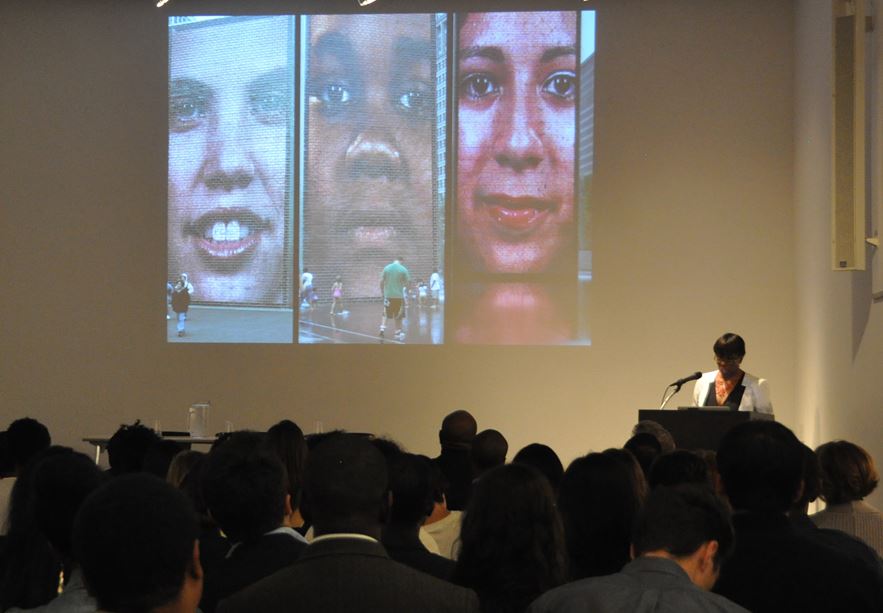by: chas
Then the hand seeks other hands to help,
A community of hands to help-
Thus the dream becomes not one man’s dream alone,
But a community dream.
Not my dream alone, but our dream.
Not my world alone,
But your world and my world,
Belonging to all the hands who build.
Langston Hughes, “Freedom’s Plow” (1943)
An excerpt from “Freedom’s Plow” is inscribed on the Langston Hughes Community Library in Flushing. On 10.04.13, AIANY Executive Director Rick Bell, FAIA, opened the J. Max Bond Lecture by reading from the poem, saying that it exemplified Bond’s belief in the need for social justice in the building, design, and workings of the city – and the Hughes Library was one of the last projects Bond worked on. Bell named Bond not only as a former teacher, but a mentor and major influence on Bell’s career. The lecture was a collaboration between the newly reinstated AIANY Diversity & Inclusion Committee, the New York Chapter of the National Organization of Minority Architects (NYCBOA/NOMA), and the J. Max Bond Center for the Just City (JMBC), carrying on Bond’s commitment to inclusion and justice in the built environment.
Toni Griffin, founding Director of the JMBC, presented the lecture, beginning with an overview of Bond’s life and work – he worked within communities on projects such as the Bolgatanga Regional Library in Bolgatanga, Ghana, and the Architecture Restoration Committee of Harlem (ARCH) beginning in the late 1960s. Throughout his career, especially mid-century, Bond’s status as a prominent African-American architect was unusual, and he brought a much-needed minority voice to the community. Griffin and many others looked up to his “love for design, his love of urbanism, his concern for social uplift.”
At this point in her own career, Griffin is striving to carry on Bond’s legacy through research at the JMBC and the courses she teaches at The City College of New York. She presented projects that her students had created, including videos, manifestos, and metrics questioning and measuring the justice of New York City. Griffin has helped develop the Just City Indicators Project through the JMBC, and is committed to finding ways to quantify social justice as a means to improving it throughout the city – an important step towards creating a truly equitable city. Another crucial goal she advocates is a higher rate of representation and education of minorities in architecture and design professions. Griffin herself enjoyed a successful career in the private sector, one of only a few women of color in a high-ranking architecture position. She shared figures demonstrating how extensive the underrepresentation is in higher education: in 2012, only 1,371 architecture students out of 26,850 (5.1%) were Black; 3,924 (14.6%) were Hispanic. These figures only get smaller in the professional realm, which has translated to an “architecture of fear” in inner cities and uninviting structures housing community centers and social services. To get closer to achieving justice, we must examine who designs our cities, and find where the barriers and gaps are in the training of design professionals.
Segregation within the urban and suburban environments – segregation of individuals, communities, and land uses – has persisted for decades despite efforts to the contrary. Griffin pointed out that the historic preservation efforts she worked on in Harlem several decades ago, in fact, contributed to the gentrification that has pushed out the lower-income residents who used to call the neighborhood home. While such issues are complicated and difficult to address, the problem of physical and social isolation in the city is multi-faceted, and design is only one component. By challenging the preconceptions of traditional architecture and urban design and examining who holds power when it comes to designing our spaces and habitats, we can begin to address social justice in the city, in the tradition of J. Max Bond.
Cassie Hackel is a community development professional with a background in multidisciplinary urban studies. She is currently a research associate with Plastarc Design Metrics.
Event: J. Max Bond Lecture | Design for the Just City: A Conversation with Toni L. Griffin
Location: Center for Architecture, 10.04.13
Speakers: Toni L. Griffin, Professor of Architecture, Founding Director, J. Max Bond Center on Design for the Just City, Spitzer School of Architecture, City College of New York, and Rick Bell, FAIA, AIANY Executive Director (opening remarks)
Organizers: AIANY Diversity & Inclusion Committee, NYCOBA/NOMA, and the J. Max Bond Center on Design for the Just City










